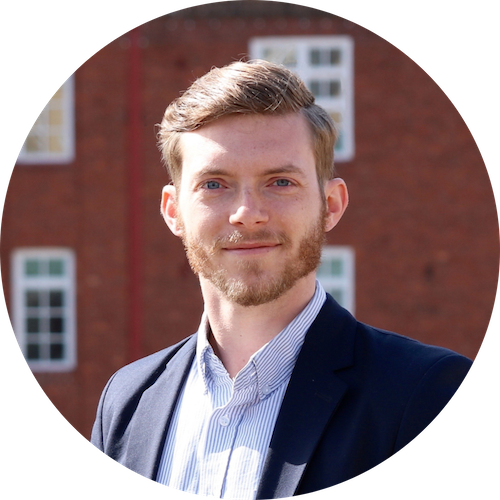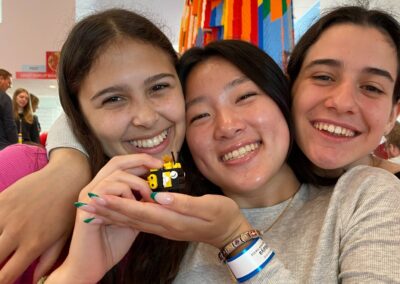Smithsonian Student Travel | New York & Denmark
Highlights
- Explore how New York City is fusing equity with design in new urban spaces
- Visit the historic Cooper Hewitt, Smithsonian Design Museum
- Discuss sustainable design at Dokk1, which uses seawater as a building coolant
- Travel to Sweden across the Øresund Bridge, a marvel of engineering
- See the creations of professional builders at the new LEGO House museum
Itinerary
This itinerary represents our plan for the program. However, we may implement changes if we identify opportunities to improve the experience, to take advantage of unexpected events, or to accommodate local schedule changes.
Arrival • Travel Day • Meet your student travel group and your trip leaders in New York City as the official start to your program.
New York City • 3 days • Begin your program with a deep dive into design in New York, a world-renowned hub of creative endeavor. Immerse yourself in the collections of the Cooper Hewitt, Smithsonian Design Museum, from art to fashion to architecture and establish a foundational understanding of the principles of design and evolution of design trends through the ages. With this context, head out to experience the city through the lens of design—visit icons of architecture, explore how green space is embedded into the design of the city, and meet with an urban designer to discuss the future of land use and city designs that seek to incorporate concepts of community, connection, and sustainability. See how these ideas have been manifested with a walk along the High Line, an abandoned section of elevated railway that was converted into a public park and greenway, and then explore some of Brooklyn’s most creative rooftop farms.
Copenhagen & Malmö • 3 days • Next, travel to Denmark to experience firsthand how the concepts of design and sustainability are inextricably linked in Danish culture. Nowhere is this link more readily apparent than in the capital city of Copenhagen, which was named UNESCO’s World Capital of Architecture for 2023 and aims to become the world’s first carbon-neutral city by 2025. Often considered the world’s most bike-friendly metropolis, with more bikes per capita than anywhere else in the world, Copenhagen has developed bike lanes with special signal lights, trash bins, and smart screen billboards with traffic information—all of which you experience first hand on an architectural exploration of the city. Learn how Danes have focused their sustainable ideals on everything from art to architecture to their food systems. Explore the famous CopenHill, a clean energy plant topped with a ski slope, playground, and hiking trail as you imagine ways that your community could reclaim unused space to promote health and sustainability. Take a day trip to Malmö, Sweden, through two feats of engineering—an underwater tunnel and overwater bridge—linking Sweden with Denmark. Visit the Swedish Form & Design center and explore the architecture of the city, built on cobblestone squares, as well as the 16th century fortress originally built by a Danish King. Compare and contrast the industrial origins of Malmo with the high-tech architecture of the Turning Torso skyscraper, the 19th-century open-air baths jutting into the sea, or the last surviving Renaissance castle in Scandinavia.
Odense & Aarhus • 3 days • Venture west and stop in Odense, home to the writer Hans Christian Andersen, and stretch your legs at Idrætspark, a sports campus awarded a gold medal by the International Olympic Committee for its playful, paradigm-shifting design work. Meet with the ambitious architect who built the site and is reimagining recreation and playground design throughout the industry. Continue on to Aarhus, Denmark’s second largest city, crowned Europe’s Culture Capital in 2017. Discuss the intersection of sustainable design and information technology with an eye-opening look at Dokk1, known as “the library of the future.” This otherworldly building is located right on the waterfront and uses seawater as a coolant and as a means to recirculate air in the ultra-efficient parking garage. Spend an afternoon at the innovative Godsbanen Cultural Center, home to local artists and host of workshops and cultural events. Check out permaculture cafes and art studios set in an urban village of yurts and cargo containers located next to the new site of the Aarhus Architecture School.
Billund • 2 days • Travel south to the 1,000-year-old waterside city of Vejle, where high school students can study marine biology next door to the award-winning “wave building” apartments. Examine the unique curves of the waterbound Fjordenhus, then head inland to the small town of Billund, capping off your time in Denmark with a stay near the home of LEGO. At the new LEGO House, spend a day creating your own cities, while checking out the mega-sized designs of professional LEGO builders.
Copenhagen • 1 day • Travel back to Copenhagen by private bus for your final night in the country. Take a stroll along the canals in the famed Nyhavn neighborhood and enjoy a final Danish meal along the water with your group.
Return • Travel Day • Fly from Denmark to New York City with your group and a trip leader, then continue on to your final destination.
Smithsonian Student Travel Experts
A Smithsonian Student Travel Expert will join the group for four or five days of the itinerary. A professional in their field, they will tie in their knowledge and experiences with the themes of the program and share their insights and passion for the region during talks and informal conversations throughout their time with the students. Meet last summer’s expert below.

Edward Becker, Architect & Professor
Edward Becker is an Associate Professor of Architecture at Virginia Tech, consistently ranked as one of the top undergraduate architecture programs in the United States. He holds a Master of Architecture with Distinction from Harvard University, and a Bachelor of Architecture from Cal Poly – San Luis Obispo. As a member of the Finnish Association of Architects, he is the founder of Helsinki-based Vor, a sustainability-focused design and consulting practice. His award-winning, bio-focused design and research work is positioned at the intersection of architecture, landscape urbanism, and public art. Edward has lived and practiced in Copenhagen and Helsinki, among other global locations, and through those experiences has a deeply rooted professional ethic for, and expertise in, sustainable design, livable cities, and design for well-being. Winner of national and international design awards from the American Society of Landscape Architects, Architizer, Architects Newspaper, Association of Collegiate Schools of Architecture, and others, his collaborative work has been published internationally by Actar, ARK, Archinect, ARQ-XP, Phaidon, Routledge, Wood Design Magazine, and World Landscape Architecture, among others, including being featured in AN’s “Best of the Best” design awards publication and Phaidon’s “Architizer: World’s Best Architecture 2020.”
What to Expect
Physical Activity • This is a physically active summer travel program. You can expect to bike, hike, and explore by foot over the course of the trip. You do not need to be at peak fitness to participate, but it is important that you have a desire to be physically active, and that you are excited about trying all activities.
Accommodations • Accommodations range from hip, centrally located hostels to small comfortable hotels and guesthouses, all with a different eye for design. Leaders stay with students throughout the program.
Climate • Summer temperatures in New York City are warm and humid, with daytime highs ranging from 70–85°F (21–30°C). Danish summers are mild and pleasant with highs ranging from 70–80°F (21–27°C), and occasionally brisker temperatures.
Meals • We enjoy meals at small, local restaurants and cafes with the occasional group picnic in the park.
Cuisine • New York City’s food scene is often touted as some of the best in the world. Cuisine is varied and reflects the city’s melting pot of cultures. Danish cuisine ranges from open-faced sandwiches and gourmet street hot dogs to hearty meals of meat and potatoes.
Language • Danish is the official language of Denmark and Swedish the official language of Sweden. However, the vast majority of Danes and Swedes speak English as a second language.
Enroll in two programs & save $1,000!
$800 tuition discount + no second application fee








